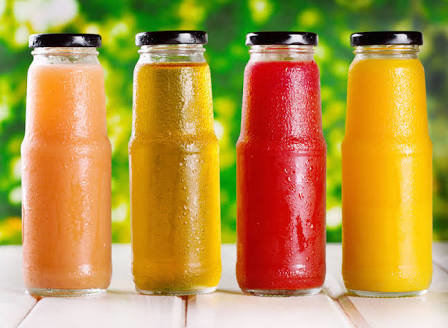Overview of Fruit Juice Processing
Juice and juice products represent a very important segment of the total processed fruit industry. Juice products are being marketed as refrigerated, shelf-stable, and frozen, in a variety of packages with increased emphasis on functionality, health attributes, new flavors or blends, and in some cases fortified with vitamins and minerals. High-quality juice operations are dependent upon a source of high-quality raw material.
Most fruit juices are excellent sources of vitamin C, several are good sources of carotene and many contain moderate amounts of pyridoxine, inositol, folic acid and biotin. Fruit juice is regarded as source of energy due to their rich carbohydrate content. The organic acids present in the fruit juice plays a significant role in the maintenance of the acid-base balance in the body.
The process starts with sound fruit, freshly harvested from the field or taken from refrigerated or frozen storage. Thorough washing is usually necessary to remove dirt and foreign objects and may be followed by a sanitation step to decrease the load of contaminants. Sorting to remove decayed and moldy fruit is necessary to make sure that the final juice will not have a high microbial load, undesirable flavors, or mycotoxin contamination. For most fruits, preparation steps such as pitting and grinding is required prior to juice extraction. Heating and addition of enzymes might also be included before the mash is transferred to the extraction stage. Juice extraction can be performed by pressing or by enzymatic treatment followed by decanting. The extracted juice will then be treated according to the characteristics of the final product.
For cloudy juices, further clarification might not be necessary or may involve a coarse filtration or a controlled centrifugation to remove large insoluble particles. For clear juices, complete de-pectinization by addition of enzymes, fine filtration, or high speed centrifugation is required to achieve visual clarity. The next step is usually a heat treatment or equivalent non-thermal process to achieve a safe and stable juice and final packaging if single-strength juice is being produced. For a concentrate, the juice is fed to an evaporator to remove water until the desired concentration level is obtained. Other processes used for water removal include reverse osmosis and freeze concentration, which are best suited for heat-sensitive juices. The concentrate is then ready for final processing, packaging, and storage.
The generalized flow chart for preparing fruit juice is shown in the given figure.
USE OF ENZYMES IN FRUIT JUICE PROCESSING
There are mainly two groups of enzyme which are used in fruit juice industry i.e. pectinases and amylases. Amylases are very important biotechnologically with applications in industries such as textile, pulp and paper, leather, detergents, beer, spirits, bread production, cereals for children, starch liquefaction and saccharification, animal feed, and the chemical/ pharmaceutical industry. From 1970 onwards the juice industry started to process edible fruits in large quantities; such fruits are picked while unripe and stored for relatively long periods of time at low temperature. Under these conditions, fruit pulp contains starch in sufficient amounts to cause turbidity or even gelatinise during processing, which makes productive procedures difficult. For this reason, the demand for amylolytic enzymes, especially glucoamylase has increased in the sector.
Pectinase was one of the first enzymes to be used and commercially applied for the processing of juices and wines. Its usage in the juice industry is related to a number of factors, especially in the clarification, maceration, and extraction, stabilisation of the juice colour during storage and increased yield. Currently, these enzymes account for approximately 20% of the worldwide enzyme market and are naturally produced by plants, fungi, yeast, and bacteria. These enzymes cause the degradation of long, complex molecules called pectin; today they have a key role in the juice industry. Pectinases are classified into three groups, according to the following criteria: Hydrolytic (hydrolases) or trans eliminative (lyases) cleavage of the glycosidic bonds; endo (randomic) or exo (from the molecule end) mechanism of action and preference for substrates, pectic acid or pectin. The three main types of pectinases are pectinesterase, depolymerising enzymes, and protopectinase.
In addition to pectinases, other enzymes such as hemicellulases and cellulase are used in the production of fruit juices, with the objective of optimising the processing of these products. These enzymes are part of maceration enzymes acting on soluble pectin hydrolysis and on cell wall components, lower viscosity, and maintenance of texture.
The enzymatic liquefaction technology is used to degrade cell wall polysaccharides, thereby releasing soluble compounds, especially the D-galacturonic acid and neutral sugars. In pulp liquefaction, pectin and cellulose hydrolysis are due to the activity of polygalacturonases, pectin lyases, pectinesterases, and cellulases. Upon the effect of these enzymes on the cell wall, neutral sugars such as D-arabinose, D-galactose, L-rhamnose, and D-xylose, which are bound to pectic substances, are released and become soluble.
Effect of Enzymatic Treatment on Juice Yield and Juice Clarification
High juice yield is an important goal for juice manufacture. Many modern processes for fruit and vegetable juice production employ enzymes as important processing aids to obtain higher yields and clarity. The use of maceration enzymes increases extraction yield and improves processing without extra costs. These enzymes are used after the cut of the raw material, in order to macerate the pulp to total or partial fruit liquefaction, thereby decreasing processing time and improving the extraction of fruit components. Upon the extraction, pectinases are added for clarification and decreased viscosity in order to facilitate filtration and concentration.
For More information kindly visit: https://encyclopedia.che.engin.umich.edu/fruit-juice/






Comments
Post a Comment